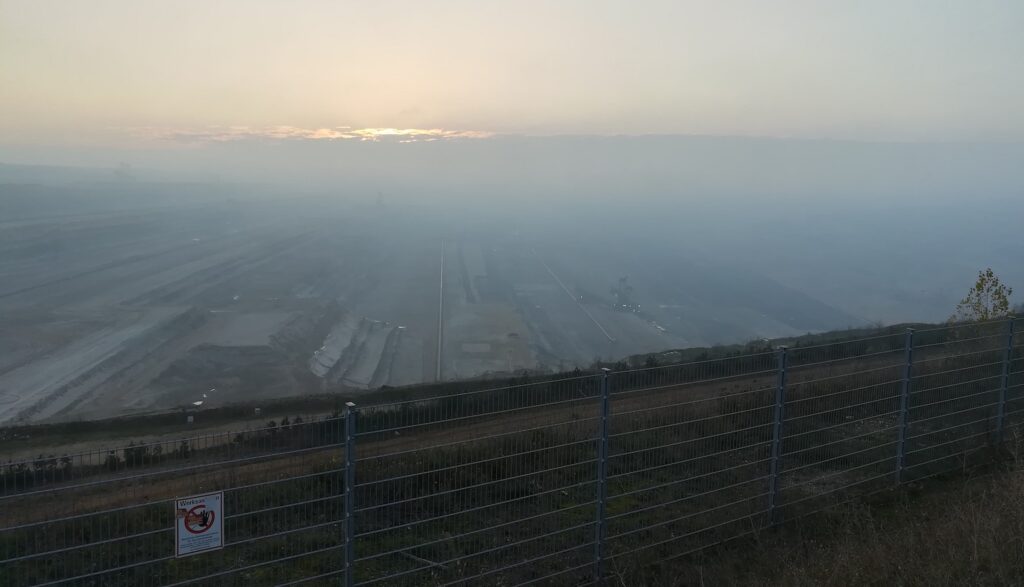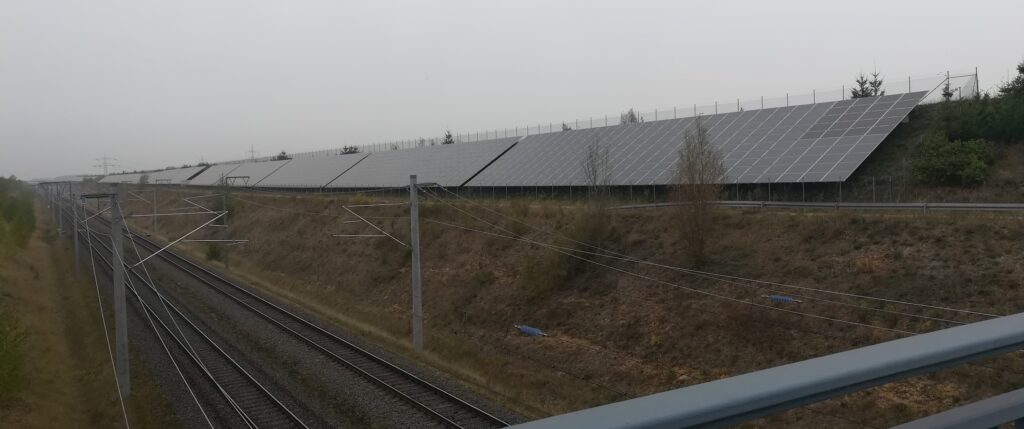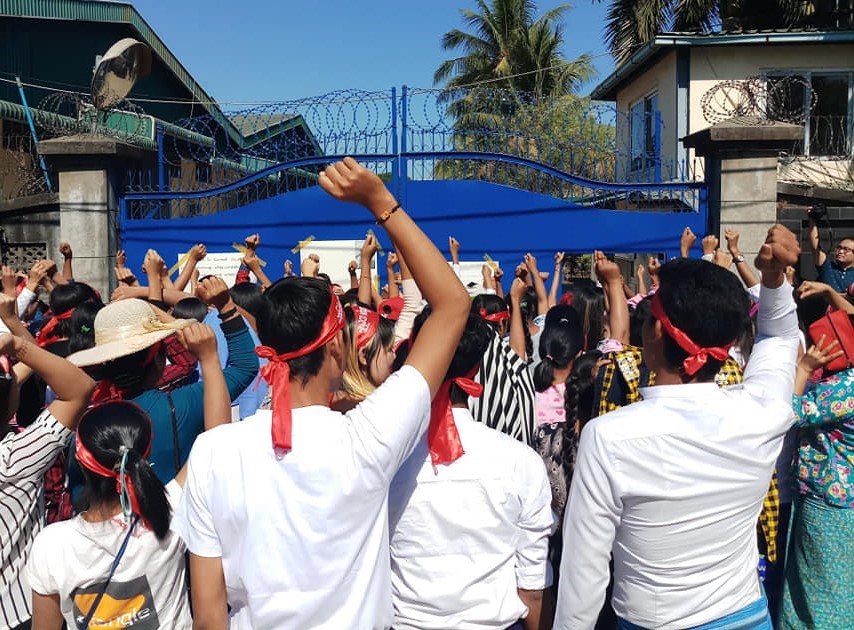This post is part of a feature on “The Political Power of Energy Futures,” moderated and edited by Katja Müller (MLU Halle-Wittenberg), Charlotte Bruckermann (University of Bergen), and Kirsten W. Endres (MPI Halle).
We are in the middle of the Rhineland’s lignite mining region, a semi-urban to rural area in the west of Germany. The landscape is considerably altered by past and present projects of large-scale resource extraction and subsequent “recultivation” measures to convert the land back to agricultural production or natural conservation. Lignite (or brown coal) is exploited in vast open-pit mines here – the Hambach mine not far from the city of Cologne is dubbed “Europe’s biggest hole” – “swallowing” everything from forests to villages in their way.
Coal mining – in contrast to the more authoritarian and centralized organization of oil extraction – has been historically associated with the development of the welfare state and the consolidation of workers’ rights in western democracies. However, as Thomas H. Eriksen notes, “contemporary coal mining has been restructured and reconfigured to resemble oil drilling formally”, becoming “less labour-intensive and more capital-intensive than in the past” (2016: 38). This neoliberal restructuring resulted not only in the transformation of institutions of “Carbon Democracy” (Mitchell 2009), as the conditions for workers to organize and wield influence over the means of production were eroded, but also in declining economic dependency on the coal industry in the Rhineland region.
Despite this decrease of economic significance in the region, RWE, the energy company currently operating the mines, has still been considerably involved in local politics over the past decades – not least because of its mandate to secure the provision of cheap electricity for German industry and consumers. To this day the state-approved “general public interest” serves as the legal basis for the suspension of fundamental rights, making possible the expropriation of land titles, the demolition of protected landmarks, or the circumvention of guidelines for environmental protection for the extraction of fossil fuels in Germany’s lignite mining regions.

Environmental destruction and relocation of tens of thousands of people due to numerous mine expansions in the Rhineland were thus firmly connected to narratives of national progress and regional prosperity. Mourning over losses of personal possessions and feelings of belonging were relegated to the private realm, and little room was left for critical voices in the public domain.
Recently however, this hegemonic state-industry nexus has been successfully challenged by a coalition of environmentalists, citizen initiatives, radical activists and other civil society actors (despite the continued economic profitability of the coal industry, ensured by “environmental load displacement” (Hornborg 2009) and other indirect subsidies). Their demands to save the remaining forest in front of the Hambach mine effectively stopped the encroaching extractivist operation. They were supported by a government commission installed to negotiate the conditions of Germany’s energy transition, following the decision to phase out the coal industry as a national contribution toward climate change mitigation.
The prospect of a global climate crisis has therefore led to the current reevaluation of lignite mining from guarantor of wealth and stability to driver of multi-scalar uncertainties. This enabled previously marginalized actors to voice their concerns by articulating their demands in terms of these globalized discourses. Yet, the (inter-)nationally reported success of the protests around the Hambach forest was only one instance of ongoing negotiations about the pace and scale of energy transition, from the perspective of the critical civil society actors with whom I conduct research in the Rhineland.
Since this seeming breakthrough for civic participation in shaping the region’s future, numerous setbacks and scandals have occurred. These are testament to the inability of carbon-democratic institutions to deal with a crisis that challenges its basic principles of growth as progress and wage labor as key to well-being. Controversies range from the passing of a coal exit law that many critical voices interpret as a “coal extension law”, to the federal government holding back an official report that questions the energetic necessity of the energy company’s plans for mine expansion.
Before the outbreak of the COVID-19 pandemic, I regularly participated in meetings of a local group of critical civil society actors who played a decisive role in saving the forest and turning it into a national symbol of climate activism. Their political engagement served as an opportunity to take a closer look at the uneven futures of energy transition in the Rhineland. As we sit in a circle in the Protestant church hall of a village close to the Hambach mine, many of the participants share impressions of feeling alienated from their home region by the energy company’s mining activities. Despite being part of the majority that does not depend on the coal industry for income, some of the locals feel their concerns were generally ignored by communal politics, making them rather skeptical of established political institutions’ capability to develop a sustainable and equitable future for the mining region.
Nonetheless, they see the impending process of energy transition as a window of opportunity to reconnect with their home region by actively participating in the development of alternative future visions, beyond institutions of representative democracy. This desire for autonomous participation is directly linked to the affective alienation associated by some of my interlocutors with the large-scale landscape transformation of the mining activities, coupled with the close connection between local politics and the energy company.
This carbon-democratic entanglement of political institutions and energy industry experienced in everyday life in the Rhineland’s lignite mining region probably finds its most drastic manifestation in the practice of “creating facts” (“Fakten schaffen”), of which my interlocutors often accuse the mining company. This expression usually refers to the practice of producing accomplished facts which alter conditions in a way to favor certain outcomes. Often their undeniable materiality forces other actors to acknowledge these facts, in turn leading to the retrospective legitimization of the outcomes of Fakten schaffen. Thus, actors with the power and institutional support to “create facts” narrow down an otherwise ambiguous situation potentially open to negotiation by different actors to a specific path of options in their interest.
In this way the energy company continues the controversial destruction of almost completely relocated villages. Under Germany’s new energy policy, the company is sticking to its operating plan and regular rhythm of extraction and redevelopment, despite radically changing socioecological and energy-political parameters. While numerous critical actors unsuccessfully appeal to democratic institutions to inhibit this pursuit of enforcing prior arrangements through material destruction, the following, more ambiguous example will serve to illustrate this modus operandi of Fakten schaffen and its relation to the feeling of alienation.

Thomas, an outspoken and very knowledgeable member of a local citizen initiative against coal mining, and part of the larger group of civil society actors mentioned above, gives me a ride to the train station after we participated in one of the regular protest-walks through the forest at the Hambach mine. As we pass the bridge over the railway connecting the mines with the nearby power plants, I decide to ask him about the solar panels aligning the tracks beneath us. Their sheer size hardly makes them unnoticeable, but I never paid much attention to them, except for contemplating the irony that the fossil fuel infrastructure gives room to more “sustainable” forms of energy generation here. After all, the solar panels seemed somewhat out of place next to passing trains packed with lignite. The panels simultaneously signal the out-of-time-ness of the coal industry and point to a new energy future on the horizon. But Thomas’ reaction to my question made me aware of another aspect regarding their significance for the issue of affective alienation in relation to the practice of Fakten schaffen.
Knowing that most of my interlocutors are in favor of direct solar energy generation and having the impressive photovoltaic structure right before our eyes, I am prepared to finally hear a success story about civic participation in local development. Yet, Thomas is not sympathetic to the photovoltaic project at all. He tells me it was a typical outcome of cooperation between energy company and politics in the region.
This sentiment echoes many civil society actors who criticize that, being the biggest landowner there, RWE conducts itself “like the lord of a manor” (“Gutsherrenart”), demonstrating the “feudal” excesses of carbon democracy in the Rhineland, which regularly undermine popular desires of stronger democratic involvement in matters of future-making. Thomas goes on to inform me that a citizen initiative proposed a similar project a few years ago in which the solar panels ought to be lining the highway that was relocated closer to the village because of the encroaching mine. They had imagined the photovoltaic structure as serving multiple other functions, such as protecting villagers from noise and air pollution emitted by the mine and highway. While the project gained some attention in the local press, it was not supported by the communal administration and ultimately had to be relinquished.
Around the same time, the energy company came to an agreement with the administration to make property available for the hitherto largest photovoltaic project in the region, co-financed by a local bank. The uncanny speed with which this project was realized confirmed not only the close ties between politics and coal industry to critical actors like Thomas, but also showed clearly how easily something can be achieved in the region when the energy company is directly involved.
So instead of being perceived as a successful step towards sustainable energy transition in the Rhineland’s lignite mining area, the solar panels symbolize a failure of civic participation. They appear to Thomas as a material (arte-)fact resulting from the dubiously close cooperation between local politics and the energy company. Judged from a distance, this instance of Fakten schaffen produced a material outcome in line with my interlocutors’ desires for sustainable energy generation. However, the concrete infrastructure stands as a monument that exemplifies how flows of innovation are caught up in existing power relations and ultimately contribute to consolidating the local incarnation of the state-industry nexus, even in the face of impending coal exit.
While the lignite industry will disappear in the foreseeable future, the longstanding history of capitalist extractivism – the main reason for the affective alienation of a large group of people in the area – will likely continue, no matter the source of energy. The deliberate promotion of technoscientific development interventions carried out by experts in the context of energy transition policies thus works to forestall the socioecological transformation from below that Thomas and others envision as a necessary step for politics in the Anthropocene.
Nowhere does this become more apparent than in the economic ministry’s newly adopted rhetoric of establishing a special economic zone in the area to speed up planning processes and pursue the double-bind of “green growth” (Eriksen 2016). Meanwhile, they were simultaneously hosting forums for civic participation that seem disconnected from this pursuit, because they operate at a different pace. This contradictory course of action leads many local actors to evaluate the efforts to integrate civil society into official planning processes as a mere façade, intensifying their skepticism towards institutions of carbon democracy in the region.
This brief insight into my fieldwork shows how inhabitants that felt alienated by collusions between energy industry and political institutions, sensed the diverging interest of politics and industry in the context of energy transition as an opportunity to regain some autonomy over the shaping of their region’s future. However, instances of Fakten schaffen enacted by the state-industry nexus function to curtail this grassroots engagement, and to (re-)connect extractive infrastructures of late industrialism (Fortun 2014) to narratives of modernization and progress under the aegis of “green growth”.
A coalition of local actors more attuned to the socioecological uncertainties of the Anthropocene criticizes this carbon-democratic variant of “cruel optimism” (Berlant 2011), and pushes for a joint transformation of resource use and political culture in search of a redefined “good life” for all. Rather than a utopian vision of future prosperity, this practical engagement might be characterized as “patchy hope” (Tsing et al. 2019) which, despite being situated and emplaced, operates between the particular and the universal, the local and the global; aware of its own limitations within ambiguous entanglements of politics and energy in the Rhineland.
Felix Lussem is a research assistant and lecturer in the field of environmental anthropology at the Department of Social and Cultural Anthropology at the University of Cologne, Germany. His doctoral research deals with shifting spatial and temporal orders in negotiations of “global crises” with a regional focus on the Rhineland’s lignite mining area. Contact: flussem2@uni-koeln.de
Bibliography
Berlant, Lauren. 2011. Cruel Optimism. Durham & London: Duke University Press.
Eriksen, Thomas H. 2016. Overheating. An Anthropology of Accelerated Change. London: Pluto Press.
Fortun, Kim. 2014. From Latour to late industrialism. HAU: Journal of Ethnographic Theory 4 (1): 309-329.
Hornborg, Alf. 2009. Zero-Sum World: Challenges in Conceptualizing Environmental Load Displacement and Ecologically Unequal Exchange in the World-System. International Journal of Comparative Sociology 50 (3-4): 237-262.
Mitchell, Timothy. 2009. Carbon democracy. Economy and Society 38 (3): 399-432.
Tsing, Anna Lowenhaupt, Andrew S. Mathews & Nils Bubandt. 2019. Patchy Anthropocene: Landscape Structure, Multispecies History, and the Retooling of Anthropology. Current Anthropology 60 (Supplement 20): S000.
Cite as: Lussem, Felix. 2021. “Alienating ‘facts’ and uneven futures of energy transition.” FocaalBlog, 7 April. https://www.focaalblog.com/2021/04/07/felix-lussem-alienating-facts-and-uneven-futures-of-energy-transition/
